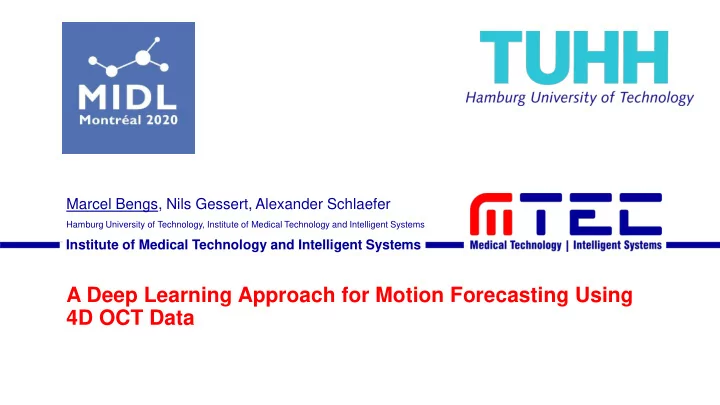

Marcel Bengs, Nils Gessert, Alexander Schlaefer Hamburg University of Technology, Institute of Medical Technology and Intelligent Systems Institute of Medical Technology and Intelligent Systems A Deep Learning Approach for Motion Forecasting Using 4D OCT Data
July 2020 Slide 2 Motivation: Motion Forecasting Radiotherapy Intraoperative Imaging Motion ROI Motion
July 2020 Slide 3 Deep Learning and Spatio-temporal OCT Optical Coherence Tomography (OCT) template 1 deep learning motion estimation (CNN) lag between the adjustment and the motion estimation moving state t motion estimation 4D deep learning motion forecasting OCT volumes over time We propose a deep learning approach for motion estimation and forecasting using sequences of OCT volumes 1 Gessert, Nils, et al. Two-path 3D CNNs for calibration of system parameters for OCT-based motion compensation. In: Medical Imaging 2019: Image-Guided Procedures, Robotic Interventions, and Modeling. International Society for Optics and Photonics, 2019. S. 1095108.
July 2020 Slide 4 Deep Learning Methods and Data Set 1 Data Set • Swept-source OCT device (OMES, OptoRes) • 40 different ROIs of a chicken breast sample • 100 different trajectories each 1 Gessert, Nils, et al. Two-path 3D CNNs for calibration of system parameters for OCT-based motion compensation. In: Medical Imaging 2019: Image-Guided Procedures, Robotic Interventions, and Modeling. International Society for Optics and Photonics, 2019. S. 1095108.
July 2020 Slide 5 Results and Discussion Using a stream of volumes improves estimation performance and allows for forecasting Motion Estimation t n Motion Forecasting t n+1 Motion Forecasting t n+2 2-Path-CNN3D (2-P-3D) n-Path-CNN3D (n-P-3D) CNN4D (CNN4D) n-Path-CNN4D (n-P-4D) GRU-CNN3D (GRUC3D)
Recommend
More recommend